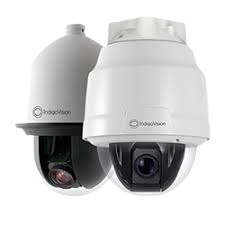Perimeter intrusion detection system
Designed for outdoor environments at the perimeter fence limits or around sensitive, high-risk and secure areas
Enhance • alert
Perimeter Intrusion Detection System (PID) is a security system designed to detect and alert the presence of intruders along the perimeter of a secure area. PID systems typically consist of a combination of sensors, such as infrared cameras, microwave barriers, or seismic sensors, that are strategically placed along the perimeter to detect movement or other signs of intrusion. The sensors send signals to a control system that analyzes the data and determines if an intrusion has occurred.
If an intrusion is detected, the system can trigger an alarm, alert security personnel, or activate other security measures, such as closing doors or triggering video cameras. PID systems are used to protect a wide range of facilities, including government buildings, military installations, airports, and commercial properties. The goal of a PID system is to provide early detection and rapid response to intrusions, helping to prevent security breaches and protect people, assets, and property.
What are the three perimeter intrusion detection systems?
- Signature-based intrusion detection
- Anomaly-based intrusion detection
- Hybrid intrusion detection
What are the different types of IDS?
- Network intrusion detection system(NIDS)
- Network node intrusion detection system
- Host intrusion detection system(HIDS)
- Protocol Based Intrusion Detection system
- Application protocol-based intrusion detection system
What does an intrusion detection system do?
Perimeter Intruder Detection Systems (PIDS) act as a technology force multiplier, they keep a constant watch on a site’s perimeter and offer the opportunity for early detection of an attack. PIDS systems are normally designed to work in a specific scenario, CPNI assure PIDS into the following categories.
What is access control and intrusion detection?
Access control and intrusion detection is a unified system that allows users to monitor and control physical access to certain areas. This form of protection can extend to physical properties and into cybersecurity.
If access control decides who is allowed to be in a certain place at a certain time (doing certain things), then intrusion detection is the process of ensuring access violations don’t occur. Intrusion detection involves constant monitoring and automatic or real-time feedback.
What is the difference between IDS and IPS?
An intrusion detection system (IDS) is defined as a solution that monitors network events and analyzes them to detect security incidents and imminent threats.
An intrusion prevention system (IPS) is defined as a solution that performs intrusion detection and then goes one step ahead and prevents any detected threats.
How does host-based intrusion detection differ from network based intrusion detection? What are the pros and cons of each?
Host-based IDSs are designed to monitor network traffic and computers, whereas network-based IDSs are only designed to monitor network traffic. HIDS are more informed of incoming security attacks due to system file and integrity monitoring functionality, keeping an eye on the system files and processes targeted by attacks. Network-based intrusion detection systems operate differently from host-based IDSes.
The design philosophy of a network-based IDS is to scan network packets at the router or host-level, auditing packet information, and logging any suspicious packets into a special log file with extended information. There are other nuances between these IDSs, so you should learn the differences between them to determine which IDS type is right for your business’s cybersecurity needs.
How does host based intrusion detection system work?
A host-based IDS is an intrusion detection system that monitors the computer infrastructure on which it is installed, analyzing traffic and logging malicious behavior. An HIDS gives you deep visibility into what’s happening on your critical security systems.
A HIDS system utilises a combination of signature-based and anomaly-based detection methods. Signature-based detection compares files against a database of signatures that are known to be malicious. Anomaly-based detection analyses events against a baseline of ‘typical’ system behaviour.
It shall detect and prevent: System scanning, denial of service(DoS) and penetration.
What is intrusion detection in CCTV?
Intrusion alert is a type of motion detection technology that will notify you whenever trespassers appear in front of your CCTV system. You can think of intrusion alert as a virtual camera operator for a fraction of the price.
What is perimeter sensing alarm?
A perimeter alarm system is an essential security measure that uses sensors, cameras, and other devices to monitor your property for unauthorized access. The control panel can be accessed physically or remotely and can sound a high-decibel siren/alarm when triggered.
How We Approach

CCTV Security System
Due to the advancements in motion detection in recent years, CCTV is now marketed as a one fits all perimeter security solution.
The promise is CCTV can now not only record an intrusion but also detect where an intrusion happens.

Access Control System
Refers to the management and restriction of entry into a secure area through a combination of physical barriers (e.g. fences, gates, walls) and electronic systems (e.g. biometric scanners, keypad entry systems, smart cards).
The access control system is designed to allow authorized individuals to enter while preventing unauthorized entry.

Fibre Optic Detection System
Used as a sensor to detect intrusions at the perimeter of a secure area. The fiber optic cable is buried underground or attached to a fence and acts as a sensitive “nerve” that can detect physical changes or disruptions along the perimeter.
Any attempt to cut, climb over, or otherwise breach the perimeter triggers an alarm. Fiber optic systems are often preferred over other types of sensors for their reliability, durability, and immunity to electromagnetic interference.

Motion Sensors
Electronic devices that detect movement within a designated area. They work by emitting and detecting electromagnetic radiation or sound waves, and can be passive (e.g. infrared) or active (e.g. ultrasonic).
When motion is detected, the sensor sends a signal to the control system, which can trigger an alarm or alert. Motion sensors are commonly used as part of a multi-layered security system to detect intrusions at the perimeter of a secure area.

Radar System
Use radio waves to detect movement within a designated area. The system transmits a signal and then receives reflections from objects in the area.
By analyzing the time delay and frequency shift of the reflected signals, the system can determine the distance, speed, and direction of objects within its range.
They are often used as part of a multi-layered security system and are particularly effective in large, open areas where other types of sensors may not be practical.

Electrified Fences
Physical barriers that are charged with an electrical current to deter and detect intrusions. When someone touches the fence, they receive an electric shock, which acts as a deterrent.
The electrical current also triggers an alarm or alert, which is monitored by the control system.
Electrified fences can be used on their own or as part of a multi-layered security system, and are commonly used to protect high-security areas such as military bases, government facilities, and critical infrastructure.

Microwave Barriers
Use microwave technology to detect and deter intrusions at the perimeter of a secure area. The system emits a microwave signal and detects changes in the field when an object enters the area. If a change is detected, the system can trigger an alarm or alert.
Microwave barriers are often used as part of a multi-layered security system and are particularly effective in large, open areas. They can also provide real-time monitoring and are less prone to false alarms than other types of sensors.
However, they can be vulnerable to interference from weather conditions and other sources of microwave radiation.

Spot Vibration Sensors
Detect vibrations caused by movement along the perimeter of a secure area. The sensors work by measuring changes in ground vibration, typically caused by foot or vehicle traffic, and sending a signal to the control system if an intrusion is detected.
Spot vibration sensors are commonly used in conjunction with other types of sensors, such as microwave barriers or radar systems, to provide multi-layered security.
They are effective at detecting intrusions in areas where other types of sensors may not be practical, such as in areas with heavy foliage or adverse weather conditions.

Microphone cable fence disturbance sensors
Sensors that use microphone technology to detect and monitor disturbances along a fence line. The sensors work by detecting changes in the acoustic field caused by movement or vibrations, such as those caused by someone climbing over a fence.
The system sends an alarm or alert to the control system if an intrusion is detected.
Microphone cable fence disturbance sensors are commonly used in conjunction with other types of sensors, such as radar systems or infrared cameras, to provide multi-layered security.

Seismic Sensors
Detect and monitor ground vibrations caused by movement along the perimeter of a secure area. The sensors work by measuring changes in ground movement, such as those caused by someone walking or driving on the ground, and send a signal to the control system if an intrusion is detected.
Seismic sensors are commonly used in conjunction with other types of sensors, such as microwave barriers or infrared cameras, to provide multi-layered security.

Electrostatic Field Disturbance Sensors
Use electrical fields to detect and monitor disturbances along the perimeter of a secure area. The sensors work by emitting an electrostatic field and detecting changes in the field caused by movement or physical contact, such as that caused by someone climbing over a fence.
The system sends an alarm or alert to the control system if an intrusion is detected. Electrostatic field disturbance sensors are commonly used in conjunction with other types of sensors, such as infrared cameras or microwave barriers, to provide multi-layered security.
